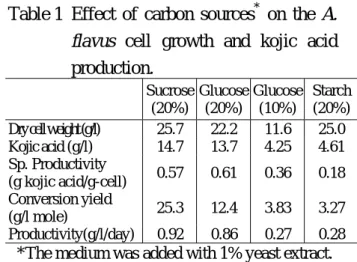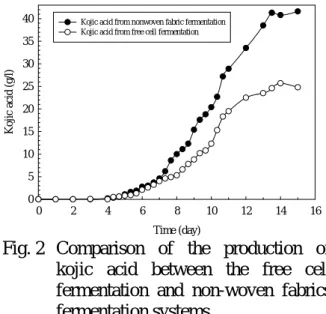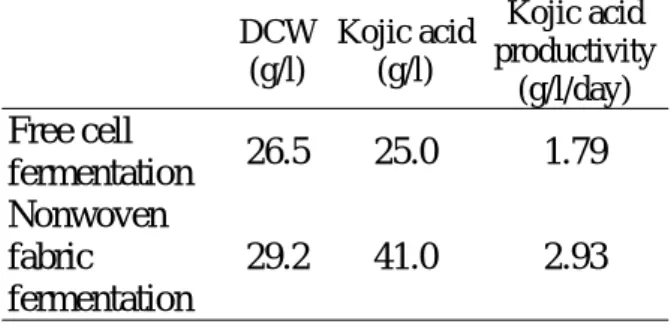行政院國家科學委員會補助專題研究計畫成果報告
※※※※※※※※※※※※※※※※※※※※※※※※※
※ ※
※ 麴 酸 醱 酵 以 及 麴 酸 衍 生 物 之 合 成 與 特 性 分 析 ※
※ ※
※※※※※※※※※※※※※※※※※※※※※※※※※
計畫類別:▓個別型計畫 □整合型計畫
計畫編號:NSC 90-2214-E-151-001
執行期間: 90 年 8 月 1 日至 91 年 7 月 31 日
計畫主持人:陳樹人
共同主持人:
計畫參與人員:林啟超、陳雅萍
本成果報告包括以下應繳交之附件:
□赴國外出差或研習心得報告一份
□赴大陸地區出差或研習心得報告一份
□出席國際學術會議心得報告及發表之論文各一份
□國際合作研究計畫國外研究報告書一份
執行單位:國立高雄應用科技大學化工系
中 華 民 國 91 年 10 月 25 日
行政院國家科學委員會專題研究計畫成果報告
麴酸醱酵以及麴酸衍生物之合成與特性分析
計畫編號:NSC 90-2214-E-151-001
執行期限:90 年 8 月 1 日至 90 年 7 月 31 日
主持人:陳樹人 國立高雄應用科技大學化工系
計畫參與人員:林啟超 國立成功大學化工系
陳雅萍 國立高雄應用科技大學化工系
一、中文摘要 麴酸是麴菌在好氣狀態醱酵下所產 生的二次代謝產物。麴酸的價格昂貴,目 前只有少數高價化妝品用之作為美白成 份。從有關麴酸生產的文獻可以暸解,在 醱酵過程中菌絲體的形態及溶氧值為影嚮 麴酸產生的重要因素。因此在本研究中將 探討攪拌式醱酵槽中加裝不織布做為細胞 固定化擔體以維持菌絲體的完整,對麴酸 生產的影嚮。 研究結果顯示當培養液之起始 pH 值 為 6.5 及其溫度為 25°C 時 Aspergillus flavus CCRC 30010 麴酸之產量最高。此時培養 液 的 組 成 為 20% sucrose 、 10% yeast extract。培養液的最佳碳氮比為 20。在懸 浮細胞的醱酵系統中,菌體於第 4 天進入 對數生長期末期,此時麴酸亦開始產生。 而在第 14 天時麴酸的產量可達最高,其值 為 25.0 g/l。然而以不織布噴交棉(Polyfilling) 為細胞固定化擔體的醱酵系統中,麴酸產 量增加到 41.0 g/l。吾人亦得到一個結果, 在醱酵系統中,以不織布做為細胞固定化 擔體,可維持菌體生長型態,避免攪拌破 壞菌絲體之完整,有利麴酸的產生。 關 鍵 詞 : 麴 酸 , Aspergillus favus CCRC 30010, 不織布, 噴交棉 AbstractKojic acid, 2-hydroxymethyl-5-hydroxy- γ-pyrone, is a secondary metabolite of
Aspergillus spp. during aerobic fermentation.
The price of kojic acid is increasing enormously since it is used as a whitening agent in the cosmetic industry. To our knowledge, the production of kojic acid is related to the mycelial conformation and dissolved oxygen tension. Since the morphology of fungus can could be maintained in the stirred tank using a non-woven fabrics, this study intended to examine effect of equipping a non-woven fabrics in a 2.5-L tank fermenter on the production of kojic acid.
It was found that the optimal condition for kojic acid production by Aspergillus
flavus CCRC30010 is sucrose 20 g/L, yeast
extract 1 g/L, temperature 25°C and initial pH 6.5. The optimal medium carbon-to- nitrogen ration was 20. In the free-cell fermentation, the mycelia entered production phase at 4 day and the maximum yield of kojic acid was 25.0g/L. In the non-woven- fabrics (Polyfilling) system, however, the yield of kojic acid increased to 41.0 g/L. It can be seen that the roles of non-woven fabrics is served as a support carried for mycelial growth. The increase of kojic acid yield may be resulted from enhancing the
stability of enzymes required for the synthesis of kojic acid in a mycelial.
Keywords: Kojic acid, Aspergillus favus CCRC30010, Non-woven fabrics, Polyfilling 二、計畫緣由與目的
麴 酸 (2-hydroxymethyl-5-hydroxy-γ- pyrone 或稱 kojic acid)是麴菌在好氣狀態醱 酵下所產生的二次代謝產物[Kwak et al., 1992]。麴酸除了可抑制革蘭氏陰性菌以及 部分革蘭氏陽性菌之生長外,亦可抑制多 酚氧化酵素(polyphenol oxidase)[Chen et al., 1991]、酪氨酸酵素(tyrosinase)[Ohyama et al., 1990 ]等酵素之活性。因此在醫藥 上,可作為抗發炎藥物與鎮痛劑,在食品 工業上可作為抗氧化劑(antioxidant)[Niwa et al., 1991],以及抗褐變劑(antibrowning agent)防止蝦類、蘋果之褐變[Iyengar et al., 1992]。另外,麴酸還具有美白的功效,因 為麴酸能搶先螯合銅離子(使酪氨酸酵素 活化之 cofactor ),使得酪氨酸酵素無法活 化,因而阻斷黑色素之生成[Uchino et al., 1988]。 麴酸是衛生署核准添加於化妝品的美 白成分之其中一種。近年來,添加有美白 成分的化妝品逐漸受到消費者的歡迎,麴 酸在化妝品上的應用也因此日益受到重 視。但由於麴酸屬於二次代謝產物,其醱 酵的產率並不高。因此本研究擬開發以不 織布為細胞固定化擔體之麴酸醱酵方法, 目的在提高麴酸醱酵產率,以降低麴酸生 產成本。 三、結果與討論 (一)麴酸生產菌之篩選 本計畫所使用之菌株購買自食品工業 研 究 所 , 包 括 Aspergillus flavus CCRC 30010, A. oryzae CCRC 30102, A. oryzae
var. effuses CCRC 31859, A. oryzae var. viridis CCRC 30428, Penicillium larosum
CCRC 31515 等五株麴酸生產菌。將單一 孢仔接種於 96-well microtiter plate 生長 並做麴酸生產測試後發現(Fig. 1):僅有 CCRC 30010 與 CCRC 30102 有較明顯的 麴酸生產能力;同時在搖瓶醱酵實驗中發 現:在 YES medium,CCRC 30010 與 CCRC 30102 之麴酸產量分別為 10.72 g/l 及 2.41 g/l。故本計畫以 A. flavus CCRC 30010 做為 探討之菌種。 Fig.1 麴酸生產之菌株篩選。具有生產麴酸的 菌株會在 plate 中呈現深紅色。 (二)培養條件對於麴酸產量之影響 實驗結果發現 A. flavus CCRC 30010 麴酸之最佳生產溫度為 25°C,pH 值為 6.0。在含有 yeast extract 的培養基中,並不 需要額外添加無機鹽類。 碳源對 A. flavus CCRC 30010 麴酸產 生之影響如 Table 1 所示,以 20%蔗糖或 20%葡萄糖作為碳源所得到之菌體濃度與 麴酸產量均十分接近,但就轉化率而言蔗 糖明顯優於葡萄糖。
Table 1 Effect of carbon sources* on the A.
flavus cell growth and kojic acid
production. Sucrose (20%) Glucose (20%) Glucose (10%) Starch (20%) Dry cell weight (g/l) 25.7 22.2 11.6 25.0
Kojic acid (g/l) 14.7 13.7 4.25 4.61 Sp. Productivity (g kojic acid/g-cell) 0.57 0.61 0.36 0.18 Conversion yield (g/l mole) 25.3 12.4 3.83 3.27 Productivity(g/l/day) 0.92 0.86 0.27 0.28 *The medium was added with 1% yeast extract.
氮源對於麴酸生產之探討方式,是以 20%之蔗糖作為碳源,在培養基中添加不同 之 氮 源 。 所 測 試 之 氮 源 包 無 機 氮 源 (NH4)2SO4、 (NH4)2SO4; 有 機 態 氮 yeast extract、peptone 以及複合氮源等。實驗發現 以 yeast extract 作為氮源可得到最高的麴酸
產量,在進一步探討蔗糖與 yeast extract 添 加 比 例 對 於 麴 酸 產 量 之 效 應 後 發 現 ( 如 Table 2 所示),最佳的碳源與氮源比例為 20,此時麴酸產量為 24 g/l。
Table 2 Effect of the ratio of carbonto nitrogen source on the A. flavus growth and kojic acid production.
Sucrose/Yeast extract
25 20 10 5
Dry cell weight (g/l) 20.5 23.4 34.0 30.5 Kojic acid (g/l) 13.2 14.1 24.0 8.25 (三)不 織 布 種 類 對 於 A. flavus CCRC 30010 麴 酸 生 產 之 影 響 本 研 究 使 用 之 不 織 布 材 質 涵 蓋 PE、PET、PP 等 聚 酯 類 加 工 而 得 之 9 種 成 品 , 實 驗 首 先 裁 剪 直徑 9 cm,厚 度約 0.5 cm 之不織布,並以去離子水將之 完全潤洷後,分別置於 250 ml 的錐形瓶 中, 內含 50 ml 的醱酵培養基 (sucrose 20%、yeast extract 1%)進行振盪培養,培 養條件為 25℃、250rpm。經過 16 天後, A. flavus CCRC 30010 之 菌 體 濃 度 及 麴 酸 產 量 如 Table 3 所 示。實 驗 結 果 顯 示 ,添加不織布確實有助於麴酸產量之提 高,並且以編號 PET (A)者效果最好,此不 織布商品名為”Polyfilling”噴交棉,為保特 瓶回收料加工再製之聚酯再生棉,其物性 與傳聚酯棉類似,具有耐熱、耐光、耐 酸性及不易褪色的特性。
Table 3 Effect of nonwoven fabrics on the production of kojic acid.
Nonwoven fibrics DCW (g/l) Kojic acid (g.l) None 22.0 24.3 PE (A) 23.5 30.2 PE (B) 23.0 29.3 PP (A) 27.0 23.9 PP (B) 23.7 26.7 PP (C) 29.0 24.6 PET (A) 20.5 35.8 PET (B) 21.6 30.1 PET (C) 27.8 33.6 Nylon (A) 25.2 30.6 * : Profilling (噴交棉) (四)在醱酵槽置入不 織 布 對 於 A. flavus CCRC 30010 麴 酸 生 產 之 影 響 在醱酵槽置入不織布之方式是裁減 2 片長度 15 cm、寬度 5 cm、厚度 0.5 cm 之 噴交棉,纏繞於醱酵 2 片擋板間,由於醱 酵槽有 4 片擋板,故可纏繞 2 片不織布。 醱酵操作條件如 Table 4 所示。
Table 4 Fermentation condition for batch culture
Strain A. flavus C C R C 3 0 0 1 0
Temperature 25°C
PH 6.0
Medium Sucrose 20%+Yeast extract 1%
Inoculum size 1×104 spores/ml
Aeration rate 500 rpm
Agitation rate 1.0 l./min
Working volume 1000 ml 懸浮醱酵系統與不織布醱酵系統之比 較如 Fig 2 所示。實驗結果發現,菌體在第 4 天時進入對數生長期未期,並開始產生麴 酸,但最高麴酸濃度可達到 25.0 g/l,菌體 濃度約為 26.5 g/l。若在 攪 拌 式 醱 酵 槽 中 置 入 不 織 布 , 發 現 於 第 14 天 時 麴 酸 的 產 量 為 41.0 g/l。 Time (day) 0 2 4 6 8 10 12 14 16 K o ji c aci d ( g /l ) 0 5 10 15 20 25 30 35
40 Kojic acid from nonwoven fabric fermentation Kojic acid from free cell fermentation
Fig. 2 Comparison of the production of kojic acid between the free cell fermentation and non-woven fabrics fermentation systems.
Bajpai 等人[1982]曾比較不同培養方式 後 發 現 : 以 靜 置 懸 浮 培 養 (static resuspension culture)得到之麴酸產量高於 振盪懸浮培養(shake resuspension culture) 得到者;其次,和破碎之菌絲體相比較,
完整之菌絲體具有較高之麴酸生產能力。 另外 Kwak 與 Rhee [1992]將 A. oryzae NRRL 484 固定於 sodium alginate 發現:細 胞固定化後麴酸之產率(3.7 gl-1 day-1)遠高 於自由細胞(2.5 gl-1 day-1)。而本研究之成果 顯示(如 Table 5 所示),以懸浮細胞醱酵系 統得到之麴酸產率為 1.79 gl-1 day-1,在醱酵 槽置入不織布時麴酸產率則可達到 2.93 gl-1day-1。此結果顯示本研究藉由不織布作 為菌體生長之支撐性擔體,亦可達到細胞 共定化之效果,不但維持菌絲體之完整, 還可免除製備固定化擔體等繁複工作。
Table 5 Comparison of the productivity of kojic acid between different fermentation systems. DCW (g/l) Kojic acid (g/l) Kojic acid productivity (g/l/day) Free cell fermentation 26.5 25.0 1.79 Nonwoven fabric fermentation 29.2 41.0 2.93 四、計畫成果自評 1. 本計畫原案核定通過部分僅為第一年 之研究計畫,此部分內容為探討麴酸醱 酵之方法,以及在醱酵槽中置入不織布 對於提高麴酸產量之可行性。 2. 本研究內容遵照原計畫案規劃進行,並 無不符合之處,且達到預期提高麴酸產 量之目標。惟此成果欲申請專利必須進 一步改善醱酵策略。 3. 本計畫成果欲發表於之名學術期刊,必 須深入探討不織布對於麴菌菌體型態 與麴酸生產之關係。 4. 本研究部分內容將發表於 2002 年亞洲 生 化 工 程 研 討 會 (YABEC 2002 Symposium Proceedings)。 五、參考文獻
1. Kwak, M.Y., and Rhee, J.S.: Characteristics of immobilized
Aspergillus oryzae for kojic acid
production. Biotechnol. Bioeng. 39: 903-906 (1992).
2. Chen, J.S., Wei, C., and Marshall, M.R.: Inhibition mechanism of kojic acid on polyphenol oxidase. J. Agric. Food Chem. 39: 1897-1901 (1991).
3. Ohyama, Y., and Mishima, Y.: Melanogenesis-inhibitory effect of kojic acid and its action mechanism. Fragrance J. 6: 53-58 (1990).
4. Niwa, Y., and Akamatsu, H. Kojic acid scavenges free radicals while Potentiating eukocyte functions including free radical generation. Inflammation 15: 303-316 (1991).
5. Iyengar, R., McEvily, A.J.: Anti- browning agents: alternatives to the use of sulfites in foods. Trends Food Sci. Technol. 3: 60-64 (1992).
6. Uchino, K., Nagawa, M., Tonosaki, Y., Oda, M., and Fukuchi, A.: Kojic acid as an anti-speck agent. Agric. Biol. Chem. 52: 2609-2610 (1988).
7. Baipai, P.; Agrawala, P.K. and Lishwanathan, L.: Production of kojic acid by resuspended mycelia of
Aspergillus flavus. Can. J. Microbiol.
28: 1340-1346 (1982).
8. Kwak, M.Y., and Rhee, J.S.: Cultivation characteristics of immobilized Aspergillus oryzae for kojic acid production. Biotechnol. Bioeng. 39: 903-906 (1992).


